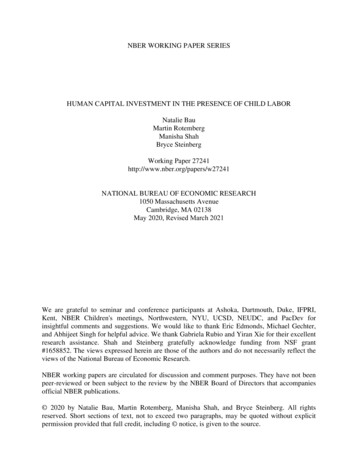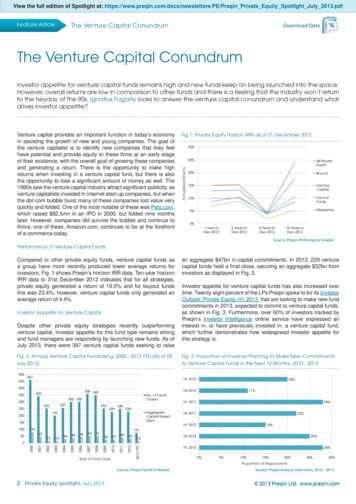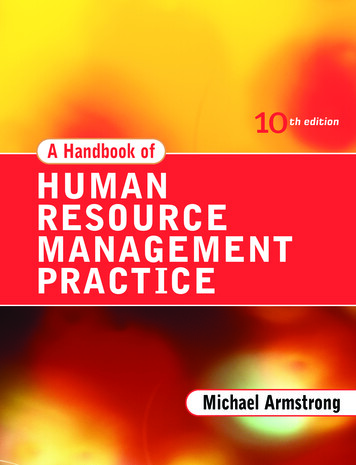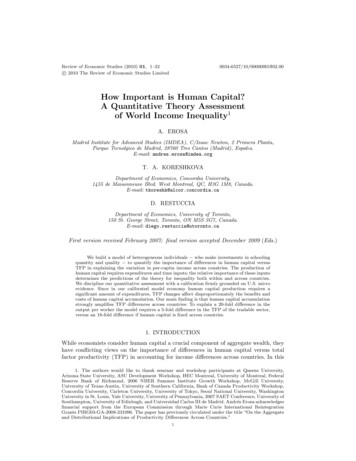
Transcription
NBER WORKING PAPER SERIESHUMAN CAPITAL INVESTMENT IN THE PRESENCE OF CHILD LABORNatalie BauMartin RotembergManisha ShahBryce SteinbergWorking Paper 27241http://www.nber.org/papers/w27241NATIONAL BUREAU OF ECONOMIC RESEARCH1050 Massachusetts AvenueCambridge, MA 02138May 2020, Revised March 2021We are grateful to seminar and conference participants at Ashoka, Dartmouth, Duke, IFPRI,Kent, NBER Children's meetings, Northwestern, NYU, UCSD, NEUDC, and PacDev forinsightful comments and suggestions. We would like to thank Eric Edmonds, Michael Gechter,and Abhijeet Singh for helpful advice. We thank Gabriela Rubio and Yiran Xie for their excellentresearch assistance. Shah and Steinberg gratefully acknowledge funding from NSF grant#1658852. The views expressed herein are those of the authors and do not necessarily reflect theviews of the National Bureau of Economic Research.NBER working papers are circulated for discussion and comment purposes. They have not beenpeer-reviewed or been subject to the review by the NBER Board of Directors that accompaniesofficial NBER publications. 2020 by Natalie Bau, Martin Rotemberg, Manisha Shah, and Bryce Steinberg. All rightsreserved. Short sections of text, not to exceed two paragraphs, may be quoted without explicitpermission provided that full credit, including notice, is given to the source.
Human Capital Investment in the Presence of Child LaborNatalie Bau, Martin Rotemberg, Manisha Shah, and Bryce SteinbergNBER Working Paper No. 27241May 2020, Revised March 2021JEL No. I2,J1,O12ABSTRACTPolicies that improve early life human capital are a promising tool to alter disadvantagedchildren's lifelong trajectories. Yet, in many low-income countries, children and their parents facetradeoffs between schooling and productive work. If there are positive returns to human capital inchild labor, then children who receive greater early life investments may attend less school.Exploiting early life rainfall shocks in India as a source of exogenous variation in early lifeinvestment, we show that increased early life investment reduces schooling in districts with highchild labor. These effects persist and are intergenerational, affecting adult householdconsumption, and lead to a divergence in the next generations' educational outcomes. Our resultsare robust to instrumenting for child labor prevalence with crop-mix and to the inclusion of a richset of district-level characteristics. We provide evidence that reductions in educational investmentin response to positive early life shocks are total welfare-reducing.Natalie BauDepartment of EconomicsUniversity of California at Los AngelesBunche Hall 8283315 Portola PlazaLos Angeles, CA 90095and NBERnbau@ucla.eduManisha ShahDepartment of Public PolicyUniversity of California, Los AngelesLuskin School of Public Affairs3250 Public Affairs BuildingLos Angeles, CA 90095-1656and NBERmanishashah@ucla.eduMartin RotembergNew York University19 W4th St, 6th FloorNew York, NY 10012mrotemberg@gmail.comBryce SteinbergWatson InstituteBrown University111 Thayer StreetProvidence, RI 02912and NBERbryce steinberg@brown.edu
1IntroductionPolicies that increase human capital investment during the critical period between the ages ofzero to five, when the developing brain is most plastic (Knudsen et al., 2006), are a promisingtool to increase long-term human capital attainment. From 2001 to 2013, the World Bankmade 273 investments in early childhood development across 80 different countries, spending3.4 billion USD (Sayre et al., 2015). The high returns of early life investments may be furtheramplified by “dynamic complementarities” in the human capital production function, whereearly skill investments increase the returns to later human capital investments (Cunha andHeckman, 2007), endogenously leading to increases in those investments.However, the success of these interventions in low-income countries could depend critically on the economic environment. This is because early interventions may also increase thepayoff from children or adolescents engaging in market work, working on the family farm, orworking in home production. In fact, the prevalence of child labor is still incredibly high inlow-income countries. The International Labour Organization estimates that there are approximately 265 million working children in the world—almost 17 percent of the worldwidechild population (Ortiz-Ospina and Roser, 2020). As a result, in environments where children have opportunities to work productively, actions taken by parents and children to alterhuman capital investments in response to positive early life shocks can reduce the positiveeducational effects of these interventions. While much of the literature on early life investment has focused on the effects of early life investment in high-income countries where childlabor is rare, understanding how parents and children respond to positive early life shocksis particularly important in low-income countries, where child labor is common (Bharadwajet al., 2013; Edmonds, 2007).In this paper, we exploit variation in early life investment due to rainfall shocks to provideevidence that increased early life investment increases the opportunity cost of schoolingby increasing the returns to child labor in rural India. We show that increased early lifeinvestment reduces schooling (and increases work) in districts with a high prevalence of childlabor. Moreover, we find that these reductions in schooling are most pronounced among girlsand lower castes, suggesting that early life investment can increase inequality and harm themost vulnerable in regions with high child labor.Importantly, these effects are both persistent and intergenerational. To assess the effectsof early life investment, we provide some of the first long-run and intergenerational estimatesof the effects of early life rainfall shocks, like Maccini and Yang (2009) in Indonesia, but ona broader set of outcomes. We show that positive early life income shocks make adults fromhigh child labor districts worse off on a variety of dimensions. By age 16, individuals in high1
child labor districts who experience positive rainfall shocks in early childhood score loweron math and reading tests. Households whose heads experienced positive early life incomeshocks in high child labor districts have lower per capita consumption.The net negative effect of a positive shock persists across generations. Children of household heads who received a positive early rainfall shock in a high child labor district aremore likely to work and less likely to attend school. In contrast, in low child labor districts,individuals who received positive early life shocks have better outcomes on all dimensions.Altogether, these results suggest that the presence of high levels of child labor can eliminatethe positive long-term impacts of early life investments and even cause these investments tomake children worse off.One important concern about the validity of these OLS results is that high child labordistricts differ from low child labor districts on a variety of dimensions. For example, highchild labor might be driven by low school quality, which could in turn attenuate the effectsof positive early life shocks. We account for omitted variable bias in two ways.First, we implement an IV strategy by exploiting an alternative, technological source ofvariation in the demand for child labor – crop variation – which is primarily driven by regions’agroclimatic features. Children are known to have a comparative advantage in some crops,such as sugar and cotton (Levy, 1985). To choose crop-based instruments in a principledway and maximize our statistical power, we follow Belloni et al. (2012) and use lasso to selectinstruments for child labor prevalence from a set of measures of the adult employment shareof total adult agricultural employment in different disaggregated agricultural industries. Theresulting instruments do include sugar and cotton, along with several other crops. Acrossoutcomes, the instrumental variables regressions deliver nearly identical results to OLS.Second, to further rule out the possibility of omitted variable bias, we also control for abattery of other local characteristics, including average incomes, literacy rates, and measuresof school quality, as well as household-specific socioeconomic controls and household fixedeffects. The inclusion of this rich set of controls has little effect on the results we observe.Decreased educational attainment and diminished long-run outcomes do not necessarilyimply that reduced schooling is welfare-reducing (Baland and Robinson, 2000). It is plausiblethat the returns to child labor are similar or greater than the returns to schooling in highchild labor areas. Efficient households may prefer additional income today to greater incomein the future. On the other hand, parents may inefficiently underinvest in the educationof their children in response to positive shocks either because they underestimate the sizeof dynamic complementarities (that is, make mistakes) or because there are incompletecontracting problems between parents and children. Incomplete contracting occurs whenimperfectly altruistic parents do not make efficient educational investments because they2
cannot capture the returns to these investments in the future (Banerjee, 2004; Ashraf et al.,2020; Bau, forthcoming). We examine whether reductions in education are consistent withwelfare-maximization in several ways.First, we allow our estimates to depend on gender and birth order. Since oldest sonstraditionally care for parents in their old age, allowing parents to partake in the returnsto their education, we expect incomplete contracting problems to be less important fortheir educational investment. Indeed, we find that for oldest sons’ parents reinforce earlyinvestments in human capital regardless of child labor prevalence. Second, we examinewhether parents are aware that positive early life shocks increase children’s cognitive ability.Parents’ assessments of the ability of children who experience positive early life shock aresignificantly higher than their assessments of those who do not, regardless of the prevalenceof child labor in the district. This suggests that parents are not simply making mistakesbecause they are unaware of their children’s cognitive skills. Finally, we use a back-ofthe-envelope exercise to estimate the maximum discount factor that would justify increasingchild labor today at the expense of future consumption if parents are perfectly altruistic. Theimplied discount factor is lower than social discount factor estimates and is also inconsistentwith Indian interest rates over the same period. Altogether, the pattern of results suggestthat parents’ inefficiently underinvest in children’s education in response to positive earlylife shocks and that at least part of this problem is driven by incomplete contracting.This paper builds on the literature on human capital investment and dynamic complementarities (Cunha and Heckman, 2008), but takes into account an important feature ofdeveloping countries: that children work (Basu and Pham, 1998; Basu, 1999; Edmonds andPavcnik, 2005). The idea that early and later life educational investments complement eachother has been directly tested in several different contexts.1 In low child labor areas, wefind revealed preference evidence of dynamic complementarities, as children who receivegreater early life investments endogenously receive more education later on.2 However, weshow that—in the presence of child labor—parents may fail to invest more in education inresponse to positive early life shocks, even in the presence of dynamic complementarities.Indeed, reduced educational investment in response to positive early life shocks does not rule1See for example Adhvaryu et al. (2018); Aizer and Cunha (2012); Agostinelli and Wiswall (2016); Gilraine(2017); Johnson and Jackson (2019); Malamud et al. (2016); Duque et al. (2020); Rossin-Slater and Wüst(forthcoming) among others. A related literature, primarily in developing countries, estimates the extent towhich parents invest unequally in their children in order to reinforce or mitigate early differences in humancapital (Behrman et al., 1994; Adhvaryu and Nyshadham, 2016; Dizon-Ross, 2019; Bharadwaj et al., 2018),whether due to dynamic complementarities or other convexities in human capital returns, and finds mixedresults.2Akresh et al. (2017) find similar, positive effects of better early life rainfall on later educational investments in Burkino Faso.3
out dynamic complementarities in the human capital production function.Our results contribute to a growing literature on the opportunity cost of schooling inboth high-income (Charles et al., 2018; Cascio and Narayan, 2019) and low-income countries(Shah and Steinberg, 2017, forthcoming; Atkin, 2016). This literature has already shownthat shocks to the opportunity cost of schooling can reduce human capital investment. Weexpand on this finding by linking it for the first time with the large literature on the longrun importance of early childhood and even pre-natal investment (Heckman, 2007; Almondand Currie, 2011; Currie and Vogl, 2013; Currie and Rossin-Slater, 2015; Attanasio et al.,forthcoming; Garcı́a et al., 2017). Consistent with this literature, we find that early lifecircumstances can have a remarkably persistent effect on outcomes throughout adulthoodand even into the next generation. Early life investments that increase children’s returnsto education but correspondingly increase the opportunity cost of schooling can negativelyaffect long-term outcomes. We provide evidence that children and parents may inefficientlyunderinvest in education in response to positive early life shocks.To guide the empirical analysis, Section 2 introduces a theoretical framework for humancapital investment and child labor in the presence of dynamic complementarities and derivestestable predictions. Section 3 provides further background on child labor in India anddescribes the data used in the analysis. Section 4 describes both the OLS and the lasso IVempirical strategies, and Section 5 reports the primary results on children’s schooling andwork using a variety of specifications. Section 6 reports the long-run and intergenerationaleffects of early life investment on adult outcomes in the presence of child labor. Section7 reports the results from a series of robustness tests. Section 8 discusses the results andprovides evidence that parents are not choosing welfare-maximizing education levels. Section9 concludes.2Theoretical FrameworkTo develop testable predictions about the effects of early life human capital investment oneducation and child labor, we develop a simple, partial equilibrium model. Intuitively, thismodel brings together the theoretical literature on child labor (e.g. Basu and Pham, 1998),the trade-off between child labor and human capital formation (Basu, 1999; Baland andRobinson, 2000; Dessy, 2000; Hazan and Berdugo, 2002; Ravallion and Wodon, 2000; Beegleet al., 2009), and the literature on dynamic complementarities (Cunha and Heckman, 2007).Doing so allows us to clarify the circumstances under which positive early life human capitalinvestments can reduce schooling, even in the presence of dynamic complementarities in thehuman capital production function. The model captures the following intuition. If there4
are dynamic complementarities, increased early life human capital investment positivelyaffects the returns to later schooling investment, incentivizing parents to invest more inlater education. This is the standard effect of dynamic complementarities posited by Cunhaand Heckman (2007). However, the new feature of our model is that in places where childlabor is prevalent, early life investments also affect the child wage, which is the opportunitycost of schooling. Thus, a novel prediction of our model is that this countervailing forceattenuates and can even reverse the positive effect of early life investment in schooling. Inthe latter case, early life investments increase the child wage more than they increase theexpected utility the parent derives from the increased return to education, causing schoolingand potentially even long-run consumption to fall. Furthermore, if the parent is imperfectlyaltruistic or she underestimates the size of dynamic complementarities relative to the effectof early life human capital investments on wages, reductions in education due to early lifeinvestments will be inefficient and total welfare-reducing.2.1Set UpThe decision-maker in the model is a parent, and each parent has one child. The decisionmaker is indexed by her child’s exogenous educational ability, α, which is distributed according to the function F and her type of district, d {low, high}, which denotes whether adistrict has high or low child labor. To simplify exposition, at the risk of abusing notation,subscripts for these indices are suppressed when not relevant. There are three periods in thechild’s life: early life, school age, and adulthood. α becomes observable in period 2, whena child is old enough to attend school. In period 1, the parent decides how much to investin a child’s early life human capital, h. In period 2, the parent makes a discrete decisioncwhether or not to educate the child, e {0, 1}, or have the child work for a wage w2,d(h),which depends on h and d.3 The parent’s consumption in the first two periods – when theparent is making human capital investment decisions – is explicitly included in the model.In addition, the parent also places some weight on the child’s third period adult utility.This can be thought of as capturing both altruism and a reduced-form representation of theparent’s third period consumption, which is determined by the fraction of the child’s thirdperiod utility that the parent captures as old age support. A parent’s preferences in period3The discrete educational investment maps to the fact that children either primarily work or attend schoolin our data, rather than moving between working and education on a continuum. This is a function of theway data is collected, which asks for a “primary activity” rather than collecting a continuous measure, suchas time spent in school and time spent working.5
1 are represented byU1p (h) u(cp1 (y1 , h)) ρE max u(cp2 (y2 , e, h))e δUc(cc3 (e, h)) ,where cp1 and cp2 are the parent’s consumption in periods 1 and 2, cc3 is the child’s adultconsumption in period 3, u is the parental utility function, U c is the child’s adult utility,which depends on educational and early life investments, δ ργ is the product of the parent’sdiscount factor ρ and γ, where γ captures both the parent’s altruism toward the child andher ability to resolve incomplete contracting problems by extracting utility from the childin the third period, and the expectation is taken over realizations of α. Both u and U c areassumed to have diminishing marginal returns in consumption.Similarly, the parent’s period 2 utility is given byU2p (e, h) u(cp2 (y2 , e, h)) δU c (cc3 (e, h)).For simplicity, the model abstracts away from borrowing and saving.4 Then, parental consumption in period 1 is equal to some exogenous income y1 net the cost of human capitalinvestment h. Parental consumption in period 2 is total income y2 net the cost of schoolingif e 1 or plus the wages from child labor if e 0. Thus,cp1 y1 ch hccp2 y2 (1 e)w2,d(h) ce ecc3 w3c (e, h) αewhere ch is a cost of the human capital investment and ce is the cost of education. w3c (e, h) αeis what the parent believes to be the child’s total adult wage, where the function w3c (e, h)allows for a flexible relationship in adult wages between e and h and does not directly dependon d, and the returns to education also depend on exogenous schooling ability α.5 Parentsmay have incorrect beliefs about w3c (e, h), such that w3c (e, h) 6 w̃3c (e, h), where w̃3c (e, h) isthe true relationship. Following Cunha and Heckman (2008), parents perceive that there are wc (0,h) wc (1,h)dynamic complementarities in the adult wage function if 3 h 3 h . This capturesthe idea that early life investments in human capital make educational investments moreproductive.4We relax this assumption in the empirical analysis and explicitly allow for the possibility that householdssave by showing that the main results are robust to household fixed effects models, which compare siblingswho received different shocks.5The fact that adult wages do not depend on d is consistent with the idea that adults can migrate toother labor markets.6
Before solving the model, we make two assumptions to simplify exposition. First, wecassume that w2,low(h) 0, so that if child labor in a district is negligible, child wages are wcalways equal to zero. In places where child labor is high, we assume 2,high 0. This hassumption captures the idea that early life human capital investments increase child wages.We directly test this assumption in subsection 3.4.2.2PropositionsWe now solve for the parent’s equilibrium investment decisions and relate them to changesin first period income y1 .cProposition 1. Denote h as the parent’s equilibrium choice of h. If w2,d(h) and w3c (e, h) 0 for all d.have constant or diminishing marginal returns in h, then h y1Proof. See Appendix A.The first proposition simply delivers the classic result that a positive income shock inearly life will increase early life human capital investment. The intuition for this predictionis straightforward. When y1 increases, the marginal utility of first period consumption falls,increasing the parent’s incentive to invest in her child’s human capital. This proposition isconsistent with the previous findings of Shah and Steinberg (2017) and Maccini and Yang(2009), who show that an early life shock increases test scores and weight.Building on Proposition 1, the next set of propositions describe the key empirical resultsin the paper – that early life shocks increase education rates in places with low child laborand have smaller positive or even negative effects on education rates in places with high childlabor. Proposition 2 delivers a standard result in the dynamics complementarities literature.Proposition 2. Denote λd (y1 ) to be the share of children educated in a district of type d w3c (1,h) w3c (0,h)(y1 ) 0onlyif .given y1 . λlow y1 h hProof. See Appendix A.This proposition captures the fact that, in low child labor places, increased h only positively affects the parent’s educational decisions through its effect on the returns to later lifeeducational investments. Therefore, if an early life shock increases educational investmentsin low child labor markets, this is evidence in favor of dynamic complementarities.The remaining propositions introduce the novel predictions of this paper. Proposition3a shows that the standard dynamic complementarity results can be reversed by opportunity costs. In high child labor markets, positive early life investments can have negativeeffects, despite their potential positive effect on the returns to education due to dynamic7
complementarities. Proposition 3b (presented in Appendix A) describes the conditions under which opportunity cost effects are not strong enough to reverse the positive effect ofearly life investment on education but nonetheless dampen that positive effect.Proposition 3a. Ifc w2,high(h (y1 )) his sufficiently great, then λhigh (y1 ) y1 0.Proof. See Appendix A.Proposition 3a shows that when the effect on parental utility of the increase in childwages due to an increase in y1 is sufficiently large in high child labor places, it outweighsthe effect of the increase in the returns to education (weighted by the parents’ altruism anddiscount factor). Then, positive income shocks that increase early life investments can leadto reduced education.Finally, our last two propositions consider some plausible circumstances under whichthese reductions in education will be inefficient. These sources of inefficiency in educational investment appear in other work (for example, Banerjee (2004) on intergenerationalincomplete contracting and Jensen (2010) on systematic under-estimation of the returns toschooling). Our contribution is showing that, in conjunction with the existence of childlabor, these forces can cause increased early life investments to have perverse effects andreduce total welfare. Additionally, modeling these sources provides us with tests for whetherreductions in schooling in response to increases in early life human capital in high child labordistricts are inefficient. We view an educational investment decision as inefficient if it doesnot maximize total welfare W2 (e; α, h), which is the sum of the parent’s and child’s utilities(equivalent to setting γ 1 in U2p (e, h)). wc (h,1) w̃3c (h,1) hProposition 4a. If γ 1 or 3 h in y1 may inefficiently reduce education.(where w3c (h, 0) w̃3c (h, 0)), then an increaseProof. See Appendix A.Proposition 4a captures two intuitive circumstances under which the reductions in educationdue to the increase in y1 (under Proposition 3a) may be inefficient. The first case γ 1captures the idea that an imperfectly altruistic parent who cannot perfectly contract with herchild to capture the returns to her investments during childhood will underweight the increasein a child’s utility in the future relative to the increase in consumption today. Thus, anincrease in y1 will reduce the parent’s returns to educating the child, even though the increase wc (h,1)in y1 increases the returns to education for total household utility. The second case 3 h w̃3c (h,1)captures the idea that dynamic complementarities are hard to observe and even a hperfectly altruistic parent may underestimate them. Thus, the parent will underestimate the8
increase in the returns to education for a child’s adult wages due to an increase in y1 relativeto the increase in the child wages, again leading the reduction in education to be inefficient. wc (h,1) w̃c (h,1)The final proposition focuses on the case where 3 h 3 h and where an increasein y1 increases the range of children for whom educational investment is efficient. w3c (h,1) w̃c (h,1) 3 h h α 0. hProposition 4b. Ifγ̄ such that for γ γ̄,and W2 (1;α ,h) h W2 (0;α ,h), hthen there exists a valueProof. See Appendix A.This proposition focuses on the case where an increase in h increases the net value of educating the marginal child more than it increases the value of the child working. In this case,it would be efficient for the marginal parent to respond to an increase in h by investing ineducation. If the parent is sufficiently altruistic or sufficiently able to contract with the childto capture the return to her investment (γ γ̄), the value of α needed for a child to beeducated will fall and the marginal child will be educated. In other words, if γ is sufficientlyhigh, the parent values the child’s adult utility enough that she responds to the increase inthe returns to education by efficiently increasing educational investment. This is easy to seein the extreme case where γ 1 and a parent is either perfectly altruistic or perfectly ableto contract with her child. In that case, education levels are never inefficient, and there willnever be an inefficient reduction in educational investment in response to an increase in h.This proposition indicates that if there is incomplete contracting between parents and children, we should see heterogeneity in the response to early income shocks across parent-childpairs with different underlying incomplete contracting problems.3Background and DataWe now describe the datasets used in this paper. We next report basic facts about childlabor in India and provide evidence that early life rainfall does indeed shock early life humancapital. Moreover, this effect is similar in both high and low child labor districts. Finally,we show that, consistent with the mechanisms in the theoretical framework, greater humancapital (in the form of both height and lagged test scores) is associated with higher childwages and makes children more likely to work in response to increased labor demand.3.1Data Sources and MeasurementThis paper utilizes a variety of datasets from India, which we describe in Table 1. Thesummary statistics for our main outcomes of interest are reported in Appendix Table A1.9
Table 1: Data SourcesData SourceTypeYearsNational Sample Survey (NSS) Schedule 1Repeated2004-2012Cross-SectionNational Sample Survey (NSS) Schedule 10RepeatedCross-SectionNational Sample Survey (NSS) Migration SurveyAnnual Status ofEducation Report (ASER)India Human DevelopmentSurvey (IHDS)University of DelawareGridded Rainfall DataUnified District Information System (DISE)Variables Usedconsumption2004-2012avg. child laborprimary epeatedCross-SectionHH Panel2005-2009dropoutmath and reading scoreschild wagesanthropometricsmath scoresDistrictPanel1970-2008rain shocksCross-Section2005education quality measures2005 and2012Notes: This table reports the different data sources (and key variables from those data sources) used in this paper.Weuse the National Sample Survey (NSS) to measure the main outcomes of interest: schoolattendance, child work, and adult consumption. The NSS is a repeated cross section of anaverage of 100,000 Indian households a year, conducted by the Indian government. We userounds 60, 61, 62, 64, 66, and 68 (2004, 2004-5, 2005-6, 2007-8, 2009-10, 2011-12) in ouranalysis. We also restrict the sample to include only rural households, since the mechanismthrough which rainfall shocks affect rural incomes (increased crop yields) is well-establishedin the literature. In contrast, wages in urban areas are less likely to be affected by rainfallshocks. We assume that children are born i
New York University 19 W4th St, 6th Floor New York, NY 10012 mrotemberg@gmail.com Manisha Shah Department of Public Policy University of California, Los Angeles Luskin School of Public Affairs 3250 Public Affairs Building Los Angeles, CA 90095-1656 and NBER manishashah@ucla.edu Bryce Steinberg Watson Institute Brown University 111 Thayer Street











